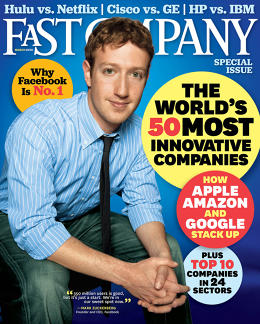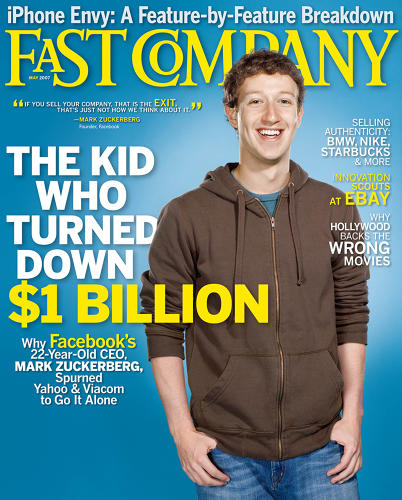In early 2007, Fast Company senior writer Ellen McGirt got a rush assignment from the magazine’s editor, Bob Safian. Both were newcomers to the publication, having recently decamped from Fortune. Safian, who had decided to kill the planned cover story for the May issue, asked McGirt to fly to Silicon Valley and do a piece on Facebook and its 22-year-old CEO, Mark Zuckerberg.
With 19 million users, Facebook was clearly a startup on the rise. But it wasn’t clear to all observers that Zuckerberg’s determination to keep the company independent was a sage strategy. After all, MySpace had sold out to News Corp less than two years earlier for $580 million, and that deal seemed pretty sweet.
The deadline was tight: McGirt would travel on Wednesday, report on Thursday, and write through the weekend so she could file her article on Monday. She was not entirely sure that she could make it happen in time, or at all.
“I was nervous that they were going to pull out at the last moment,” she says. “I ended up sitting outside Facebook the day before I was supposed to go in.” She observed Zuckerberg departing the premises, walking his bike: “Okay, that was creepy, but at least I can say I’ve seen him.”
When the formal interview began the next day, as McGirt recalls, Zuckerberg arrived with a bowl of Cheerios in hand. She asked him about a tale she’d heard involving a man who’d approached him at a gas station, ranting and brandishing a gun. “That is not relevant to the story,” he snapped. “It is if I say it is,” she replied.
“He burst out laughing, and we were fine after that,” she says. “I liked him immediately, and liked him tremendously.”
McGirt made her deadline, with a story the magazine ended up calling “Hacker. Dropout. CEO.” It was the first of six times Zuckerberg and Facebook have made our cover, including our new issue, which features my deep dive into the company’s plan to extend its mission of connecting the world—which now includes wildly ambitious efforts in artificial intelligence, virtual reality, and Internet drones.

MAY 2007: THE VERY PATIENT 22-YEAR-OLD
TOTAL FACEBOOK USERS: 19 MILLION
This first Fast Company cover story on Facebook came early enough in the game that it was not unreasonable to point out, as the article did, that social-networking pioneer Friendster had spurned Google’s offer to buy it for $30 million in 2002, and went on to struggle as an independent entity. Was Mark Zuckerberg—who had reportedly turned down a $750 million bid from Viacom and a $1 billion one from Yahoo—being greedy?
“I’m here to build something for the long term,” Zuckerberg told McGirt. “Anything else is a distraction.” History has shown that he meant what he said, and that he was wise to spurn advances from acquisitive media giants.
Just six months later, McGirt wrote another major feature, “Facebook Is The ‘It’ Company Of 2007.” This one wasn’t the issue’s cover story, but the fact we returned to the company so quickly was a sign of how rapidly it was growing, evolving, and solidifying its position as one of the industry’s giants.

MARCH 2010: THE INNOVATOR
350 MILLION ACTIVE USERS
When we ranked Facebook as the world’s most innovative company, Zuckerberg returned to our cover after almost three years. He looked rather corporate on this cover, in a necktie and pinstriped shirt—because the photo shoot took place in late 2009, the year he pledged to wear a tie every year to emphasize what a serious year it was for the company. (Once the mission was accomplished, he went back to gray T-shirts.)
By 2010, the era of pundits wondering if Facebook might be an acquisition target was long over. Though the company still hadn’t gone all out to monetize its users, it was cash-flow positive, and Zuckerberg told McGirt that it was in a sweet spot—not too small, and not overwhelmingly large. At the time, it was focused on immediate goals such as cleaning up old code and building new features. But for Zuckerberg, managing was already about the long term, and the fact that he maintained control of Facebook gave him latitude to make mistakes, experiment, and plan for the future. “I’m not going to be fired if I have a bad year,” he said. “Or a bad five years.”

NOVEMBER 2011: THE TECH WARRIOR
800 MILLION USERS
For “The Great Tech War Of 2012,” Farhad Manjoo looked at the battle between the industry’s titans to be its dominant force. Rather than declaring a victor, we sneakily created fourdifferent versions of our cover: “Why Amazon Will Win,” “Why Apple Will Win,” “Why Facebook Will Win,” and “Why Google Will Win.”
In the case of Facebook, Manjoo highlighted several strengths, including its success at recruiting Silicon Valley’s best engineers, its place at the epicenter of digital advertising, and the vast amount of data it collected on its users and their interactions with each other. The company was also responding adroitly to what seemed like a potential threat at the time: Google’s then new social network, Google+.

APRIL 2012: THE PUBLIC-COMPANY CEO
845 MILLION USERS
When this issue appeared, Facebook was about to go public. McGirt drew on her more than 400 cumulative hours of reporting about the company to tell the story of how Zuckerberg and his company had—and hadn’t—changed over the years. “For an idea that has turned into a company,” she wrote, “Facebook has done a remarkable job of using its collaborative philosophy to develop the workforce it had into the innovators it needed.”
In another story on the challenges Facebook would confront after its IPO, Manjoo noted that pundits had speculated about the company taking on Amazon, Apple, or Google by building a phone, search engine, mobile operating system, or Amazon Web Services-like cloud platform. He said such copycat efforts were unlikely to work. More than four years later, Zuckerberg has flicked at some of those ideas—such as with the notably unsuccessful Facebook Home interface for Android—but has mostly chosen to follow his own path.

JULY/AUGUST 2014: THE MOBILE MASTER
1.3 BILLION USERS
Facebook’s first stab at mobile apps is most famous for being a mistake: It started out thinking it could use web technologies to build one version of the service that would work well on any device. After dumping that plan in favor of creating full-blown native apps, it not only rebounded, but thrived.
Austin Carr’s feature on the company’s mobile strategy focused on the company’s plan to keep that momentum going, which included everything from relatively straightforward efforts—keeping Instagram growing, helping third-party developers build and monetize products—to daring gambits such as the acquisitions of WhatsApp and Oculus VR.

DECEMBER 2015: THE FUTURIST
1.5 BILLION USERS
Once upon a time, fulfilling Facebook’s mission of connecting the world mostly involved getting people to sign up for Facebook, then giving them useful features. With a billion people a day now using the service, the company has already done the obvious things. What lies ahead are new challenges, such as bringing the Internet to people who aren’t yet online at all, and thinking about what social networking might be like a decade or more from now.
So when I spent time with Zuckerberg to hear his vision straight from the source for our new cover story, we mostly talked about the future. Besides getting ready to ship Oclulus’s Rift headset, Facebook is ramping up its artificial-intelligence lab and preparing to launch test flights of Aquila, the drone it plans to use to bring connectivity to remote parts of the world. Zuckerberg does not seem interested in tamping down expectations. “These things can’t fail,” he told me. “We need to get them to work in order to achieve the mission.”
As for Ellen McGirt, her reporting has recently involved shadowing Bono on his globe-spanning charitable efforts—which, last September, took him and her to the United Nations’ sustainable development summit.
“All of a sudden, someone came out of a side door, and it was Mark and his entourage,” she says. “I literally ran into him. And I was like, ‘Mark, remember me?’ From that bowl of cereal to addressing the U.N. as one of the most important business leaders in the world. He turned out just fine.”
[“source-fastcompany”]

